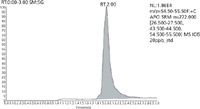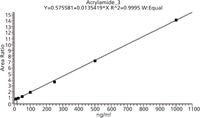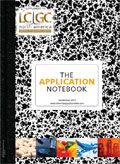Acrylamide by QuEChERS Extraction with LC–MS-MS Detection
Acrylamide is a neurotoxic compound classified as a probable human carcinogen and genotoxicant (1). In 2002, researchers in Sweden uncovered the presence of acrylamide in certain fried and baked foods at relatively high levels (2).
Acrylamide is a neurotoxic compound classified as a probable human carcinogen and genotoxicant (1). In 2002, researchers in Sweden uncovered the presence of acrylamide in certain fried and baked foods at relatively high levels (2). Acrylamide is formed during cooking at high temperatures through the Maillard reaction of asparagine and reducing sugars. This application provides a quick and easy extraction of acrylamide from a variety of food matrices.

Extraction Procedure
a) Add 5 g of homogenized sample to a 50 mL centrifuge tube
b) Fortify with internal standard
c) Add 10 mL of reagent water, vortex briefly
d) Allow ≥15 min for hydration
e) Add 10 mL of acetonitrile, vortex briefly
f) Add salts from Mylar pouch (ECMSSC50CT-MP)
g) Shake vigorously for 1 min
h) Centrifuge at 5000 rpm for 10 min
i) Supernatant is ready for cleanup

QuEChERS Cleanup
LC: Thermo Accela 1250 pump
- Column: Sepax C18, 150 mm × 2.1 mm, 3 µm
- Guard: Restek C18 2.1 × 20 mm
- Column Temperature: Ambient
- Injection volume: 20 µL
- Mobile Phase: A: water; B: methanol
- Gradient: 0–3 min: 100% A; 5–6 min: 100% B; 7–12 min: 100% A
- Flow Rate: 200 µL/min
- MS/MS: Thermo TSQ Vantage
- Ion source: positive APCI

Figure 1: Chromatogram of a 10 ng/mL matrix-matched std.
Conclusions
A QuEChERS method has been successfully developed for the extraction and purification of acrylamide in various food matrices. PSA and C18 in the dSPE step eliminates the need for hexane defatting and results in clean extracts.

Figure 2: Calibration curve with a 10â1000 ng/mL concentration range.
References
(1) Zhang et al., New research developments in acrylamide: analytical chemistry, formation mechanism and mitigation recipes, Chemical Reviews 109, 4375–4397 (2009).
(2) Swedish National Food Administration, Information on acrylamide in food. April 24, 2002, www.slv.se
UCT, LLC
2731 Bartram Road, Bristol, PA 19007
tel: (800) 385-3153; e-mail: methods@unitedchem.com
Website: www.unitedchem.com
















